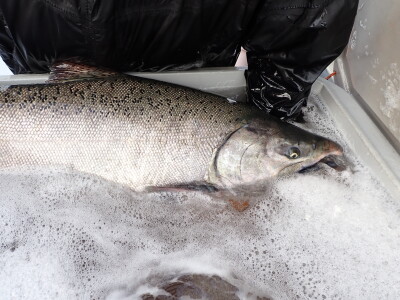Cover story excerpt: A stand on tuna
In the United States, there is broad agreement that ICCAT must do better on bluefin
By Jerry Fraser
During the summer of 1973 I was working as a deckhand, whiting fishing with Lester Orcutt on his 47-foot dragger Minkette, when the Japanese freezer-longliner Tatsumi Maru showed up in Portland, Maine.
The Tatsumi Maru had steamed halfway around the world to set longline in 60-mile shots in a hit-or-miss effort to catch bluefin tuna, which was — thanks to Japanese palates — beginning to come into its own in the global market for seafood.
Whiting fishing was a grind. We'd steam at 3 a.m. and catch our 10,000-pound fish-house limit in an hour or two only to wait all day to unload for a nickel a pound, minus a penny for the lumpers.
And working the bottom with 40 or 50 other draggers in a tow not much bigger than a duck pond was wearing on Orcutt. So when Phil Willard, a Portland fish buyer, offered us five miles of tuna longline gear, we couldn't pass it up. We put the whiting net on the dock, buoyed the doors and trawl warps off in shoal water, and wound our borrowed longline onto the winch.
Unfortunately, the vast scope of the Tatsumi Maru's longline had obscured the fact that the Japanese were catching bluefin in accordance with the same principle by which blind squirrels find acorns.
We set the longline just below the surface, suspended from large glass floats encased in nylon mesh, and it soon became clear to us that five miles of longline is not a lot of gear when you are chasing highly migratory fish and have no idea where they are. If there were any tuna around, they were oblivious to our gear or indifferent to our frozen bait.
The same cannot be said about the sea gulls and bluedog sharks in the area, and we spent two interminable weeks banging away with a .410 in a vain effort to shoo them away from our hooks, never laying eyes on a tuna, and before long we were grappling up our trawl gear.
What had we been thinking of? Well, for one thing, at 32 cents a pound, a couple of tuna a day and we'd have been way ahead of the whiting business.
More than that, though, we had the fever. The bluefin is one of nature's most majestic fish. It is a swift and powerful swimmer whose range spans oceans and whose weight can exceed 1,000 pounds, although U.S. fishermen seldom lay eyes on fish of this heft anymore, unless they're leafing through a scrapbook.
Those old pictures will recall an era when bluefin tuna were cheap and, most years, plentiful, a time when Maine lobstermen could haul traps in the morning and jog a few miles offshore in the afternoon to try their luck with the harpoon.
Commercial fishermen in the northwest Atlantic also chased bluefin with purse seines and handlines, and there were recreational fisheries as well. Indeed, considering the pittance paid for tuna — on a given day you might fill the boat with them and not make money enough to pay the trucking — you could make the case that it was all a recreational fishery.
That changed in the year or two before the Tatsumi Maru showed up. The average price of tuna, which had languished between 6 and 8 cents throughout most of the 1960s, rose to 15 cents in 1970, 41 cents in 1974, 72 cents in 1978 and $1.21 in 1979, according to NMFS.
(Such prices themselves would look like small change in the following decade. Average prices topped $3 in 1984, $5 in 1987, and $9 in 1990.)
The axiom that nature abhors a vacuum speaks to no phenomenon so much as a fishery in which a tenfold increase in landings is accompanied by a 150-fold increase in price.
Prices today have for the most part retreated from the highs of a decade or so ago, thanks at least in part to pen-rearing of wild-harvested bluefin, mostly in the Pacific and the Mediterranean. And fuel prices upward of $4 a gallon have cut into profit margins.
But bluefin with the high fat content sought by sushi and sashimi purveyors continue to command good money, and the fish have lost none of their majesty, so many American fishermen with a track record of success have hung on, even if for love as much as money.
But the domestic fishery is just a small piece of the puzzle. As highly migratory species, bluefin are among stocks managed by ICCAT, the Madrid-based, 46-member International Commission for the Conservation of Atlantic Tunas, formed in 1969 to monitor the effect of fishing on stock abundance for the purpose of establishing quotas.
Trouble is, stocks are not abundant. According to NMFS, the spawning stock biomass of bluefin in the western Atlantic is about 19 percent of the 1975 reference year and 41 percent of the level necessary to support maximum sustainable yield.
The good news, such as it is, according to Victor Restrepo, director of the Sustainable Fisheries Division of the Southeast Fisheries Science Center and chief scientist for the U.S. ICCAT delegation, is that "some progress is being made, very slowly, to rebuild the stock." But there is, he conceded, "some uncertainty about the level the stock could be rebuilt to."
NMFS attributes this uncertainty to poor recruitment over the past three decades.
"The biomass of the spawners, of the large fish, is building up slowly... the progress is not as fast as we would have hoped in the past," Restrepo says.
"We seem to have had overly optimistic projections," says Rebecca Lent, director of NMFS' Office of International Affairs, "so we may need to make an adjustment there."
Rich Ruais, executive director of the East Coast Tuna Association and the Blue Water Fishermen's Association, as well as editor of the Web site Tuna News, says the problems surrounding bluefin are "complex."
"I don't think it's any one issue," Ruais says. "I don't think it's just resource oriented, but resource is part of it."
For one thing, he says, "We are getting a fraction of the fish we used to get emigrating from the east to the west."
Then there is a warming trend. This, he says, "is resulting in a change in both the production level and the distribution pattern of phytoplankton," and ultimately, "a northern distributional shift in several species."
Restrepo doesn't disagree. "There is apparently a change in the distribution of fish that is affecting different fisheries in different ways," he says.
Canadian fishermen appear to be beneficiaries. "The Canadian bluefin fishery is roaring this year," Ruais says. "The [Prince Edward Island] fishery is the highest it's ever been on historical record."
Finally, Ruais believes that forage stocks off New England have improved as a result of the seasonal ban on midwater trawling in the inshore waters of the Gulf of Maine. He points to increased landings of bluefin this summer as evidence of the ban's effectiveness. "There's been a little bit of improvement, and there could be more as we see herring begin to increase and stay in the coastal zone for a longer period," he says.
Complicating the picture is the U.S. failure to catch its quota, which is being eyed lustily by Canada. And although the factors of abundance cited by Restrepo and Ruais speak as well to geographic distribution, U.S. fishermen like Steve Weiner, a former ICCAT adviser and a longtime Ogunquit, Maine-based harpoon tuna fisherman, fear any quota pried from the United States will be gone for good. "We don't have that big a quota as it is," Weiner says.
Moreover, he says it's unlikely tuna landings reflect abundance, given the vast amount of dogfish off the Eastern Seaboard.






